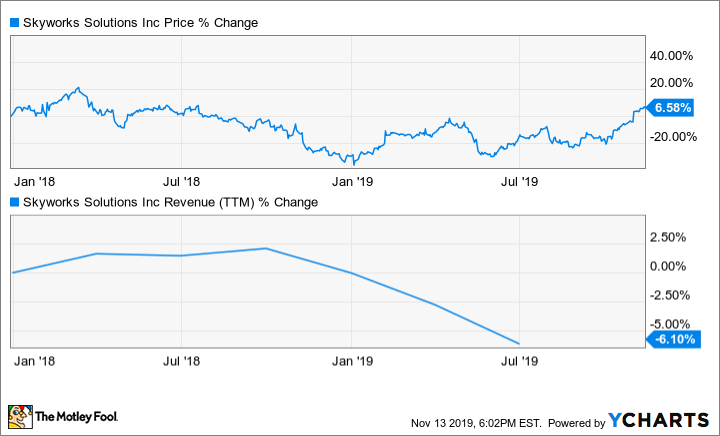It's been a wild ride the last few years for Skyworks Solutions (SWKS 0.81%) -- really for the broader chip-making industry in general. On one hand, technology -- especially of the variety that hooks up to the internet or some other network -- is more important than ever before. But on the other, being a hardware supplier has always been a cyclical business. This year, Skyworks, which made its name riding the coattails of Apple's (AAPL +0.13%) iPhone and other smartphone options, has hit a speed bump as demand for consumer mobile devices has tapered off and matured.
Add to the mix a White House ban on selling to China's tech giant Huawei, and Skyworks has been in a real pickle this year. Sales are down sharply from a year ago, and there's still no forecast as to when that will change. Nevertheless, the arrival of 5G mobile network upgrades has come just in time, and the possibilities of those upgrades are keeping shares propped up.
Data by YCharts.
Tough times linger, but there's a glimmer of hope
Skyworks' fiscal 2019 fourth quarter (the three months ended Sept. 27, 2019) revenue fell 18% year over year to $827 million. As a result, adjusted earnings per share that back out onetime nonrecurring charges tumbled 22%. Ouch.
Paired with the rest of fiscal 2019, the impact from losing Huawei in the spring and a sluggish showing in iPhone and other smartphone sales made for a tough year.
|
Metric |
12 Months Ended Sept. 27, 2019 |
12 Months Ended Sept. 28, 2018 |
Change |
|---|---|---|---|
|
Revenue |
$2.55 billion |
$2.86 billion |
(13%) |
|
Gross profit margin |
47.5% |
50.4% |
(2.9 pp) |
|
Operating expenses |
$652 million |
$631 |
3% |
|
Adjusted earnings per share |
$6.17 |
$7.22 |
(15%) |
Data source: Skyworks Solutions. Pp = percentage point.
Despite the headwinds, Skyworks' stock has still managed a 7% return since the start of 2018 and a 39% return over the last 12-month stretch as of this writing. The reason for the advance is that the company has been showing sequential quarterly improvement as the year has gone on. During Q4, for example, revenue increased 8% from Q3. When Huawei is excluded from the equation, revenue grew 20% from Q3, which management said was one of the company's best sequential increases ever.
That's important because Skyworks has been trying to diversify its business away from smartphone dependence for years. 5G mobile networks (Skyworks is supplying chipsets for 5G-capable phones as well as infrastructure equipment for mobile providers building the network) and the growing importance of the Internet of Things is finally providing a payoff. During the first quarter of the new 2020 fiscal year, Skyworks expects another 6.5% sequential sales increase from Q4 -- although the $870 million to $890 million revenue and $1.65 per share adjusted earnings forecast implies a 9.5% and 11% decrease, respectively, from the comparable period a year ago.

Image source: Getty Images.
Patience is often rewarded
5G is really just getting rolling and could be a strong mover for Skyworks in the next couple of years -- with or without Huawei business running at full steam. While not offering specific full-year 2020 guidance, CEO Liam Griffin did say momentum is building for 5G headed into the new year. He said there are 5 billion mobile phone subscribers worldwide, and upgrades from current 3G and 4G networks will provide the initial surge in demand for Skyworks' portfolio of 5G chips.
In the longer term, though, the technology goes far beyond faster phone download speeds. 5G can help power autonomous vehicles, connected manufacturing and healthcare, and artificial intelligence, to name just a few use cases. That cycle of build-out to make use of the network is only just beginning, and future needs could mean Skyworks finally reignites its growth engine in the years ahead.
Thus the big rebound in share price this year. Skyworks Solutions stock trades for 24.8 times the last year's worth of free cash flow (basic profits after operating and capital expenses are paid) after the run-up in the share price. That's a little steep for a company still reporting business declines from year-ago comparable periods, so I'm not a buyer of the stock at this point (though I was early in the year); I'm waiting to see an actual annual increase in sales and earnings before I'll add to my existing position, or for another sizable pullback in share price as often happens with this cyclical stock. But for investors looking at the long term, this connectivity chip maker needs to be on watch lists.





